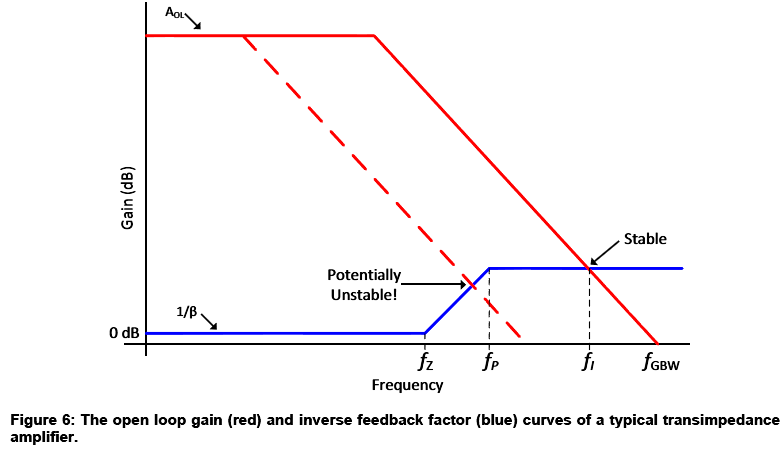What is the open loop gain limit that I must stay below for stability when making a transimpedance amplifier with an op amp? Why am I allowed to exceed the open loop gain? Why does the gain limit of a transimpedance amp roll off at more than 20dB/decade?
I am trying to make a transimpledance amplifier for a photodiode. For stability, the gain of an op amp must intersect the open loop gain of the op amp at a 20dB/decade angle. Here's a graph from TI's document # TIDU535 that illustrates this point:
This document is contradictory in a way. The example in figure 10 (in the doc TIDU535) uses a feedback resistor of 53.6KΩ for a gain of 94.6dB. The circuit gets a -3dB roll off at 1.464MHz. The op amp has an open loop gain (Aol) of ~130dB and a GBW of 20MHz. This op amp should roll off at 373Hz due to the limits of the GBW and Aol.
Thomas Kuehl address this concern here: https://e2e.ti.com/support/amplifiers/precision_amplifiers/f/14/p/379953/1338396#1338396
He essentially says you can exceed Aol because Aol only applies to amplifying volts to volts. A transimpedance amplifier is amplifying current to voltage so Aol can be exceeded. Unfortunatly, he doesn't explain why Aol can be exceeded, only that it is.
There is a limit according to simulation. This simple setup in TI-TINA shows that I can get 120dB of gain at 5.8MHz out of an op amp with an Aol of 110dB and a GBW of 100MHz. The other confusing thing is that the rolloff is ~46dB/decade instead of the normal 20dB/decade we see when amplifying volts to volts.
What is the open loop gain limit that I must stay below for stability when making a transimpedance amplifier with an op amp? Why am I allowed to exceed the open loop gain? Why does the gain limit of a transimpedance amp roll off at more than 20dB/decade?
TI has done an amazing job of providing resources that hold your hand through the design of this circuit, but I need to know why/how it achieves the gain it does despite Aol limits, and more importantly how to ensure my circuit is stable.



